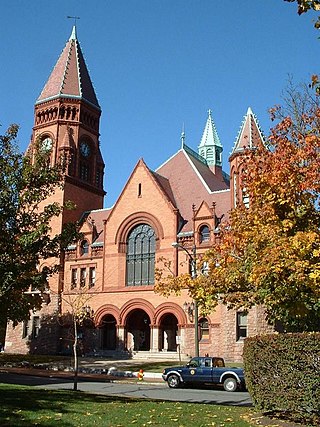
Fairhaven is a town in Bristol County, Massachusetts, United States. It is located on the South Coast of Massachusetts where the Acushnet River flows into Buzzards Bay, an arm of the Atlantic Ocean. The town shares a harbor with the city of New Bedford, a place well known for its whaling and fishing heritage; consequently, Fairhaven's history, economy, and culture are closely aligned with those of its larger neighbor. The population of Fairhaven was 15,924 at the time of the 2020 census.

New Bedford is a city in Bristol County, Massachusetts, United States. It is located on the Acushnet River in what is known as the South Coast region. It is the largest city in the region and second largest city in the Providence-Warwick-New Bedford Metropolitan Region. Up through the 17th century, the area was the territory of the Wampanoag Indians. English colonists bought the land on which New Bedford would later be built from the Wampanoag in 1652, and the original colonial settlement that would later become the city was founded by English Quakers in the late 17th century. The town of New Bedford itself was officially incorporated in 1787.
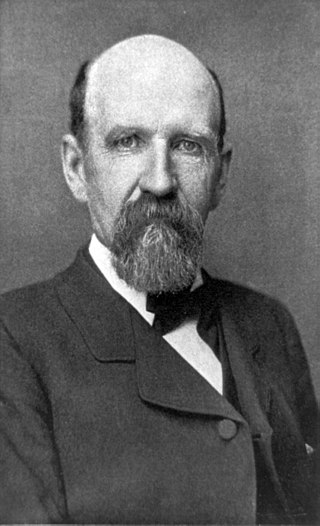
Joshua Slocum was the first person to sail single-handedly around the world. He was a Nova Scotian-born, naturalised American seaman and adventurer, and a noted writer. In 1900 he wrote a book about his journey, Sailing Alone Around the World, which became an international best-seller. He disappeared in November 1909 while aboard his boat, the Spray.
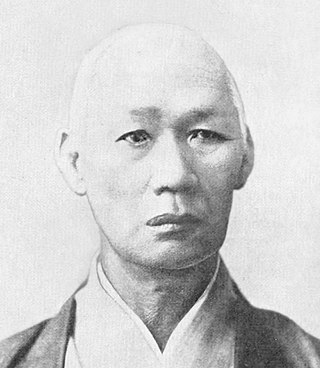
Nakahama Manjirō, also known as John Manjirō, was a Japanese samurai and translator who was one of the first Japanese people to visit the United States and an important translator during the opening of Japan.

Tosashimizu is a city located in the southwest of Kōchi Prefecture, Japan. As of 31 July 2022, the city had an estimated population of 12,407 in 7004 households, and a population density of 47 persons per km2. The total area of the city is 266.34 square kilometres (102.83 sq mi).

Charles W. Morgan is an American whaling ship built in 1841 that was active during the 19th and early 20th centuries. Ships of this type were used to harvest the blubber of whales for whale oil which was commonly used in lamps. Charles W. Morgan has served as a museum ship since the 1940s and is now an exhibit at the Mystic Seaport museum in Mystic, Connecticut. She is the world's oldest surviving (non-wrecked) merchant vessel, the only surviving wooden whaling ship from the 19th century American merchant fleet, and second to USS Constitution, the oldest seaworthy vessel in the world. Charles W. Morgan was designated a National Historic Landmark in 1966.
Wamsutta Oil Refinery was established around 1861 in McClintocksville in Venango County near Oil City, Pennsylvania, in the United States. It was the first business enterprise of Henry Huttleston Rogers (1840–1909), who became a famous businessman, industrialist and financier.
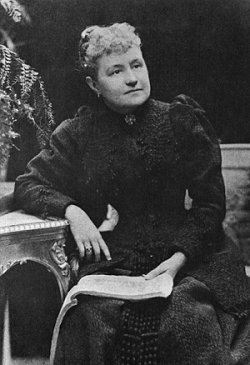
Abigail Gifford Rogers was the first wife of Henry Huttleston Rogers (1840–1909), an American business magnate.
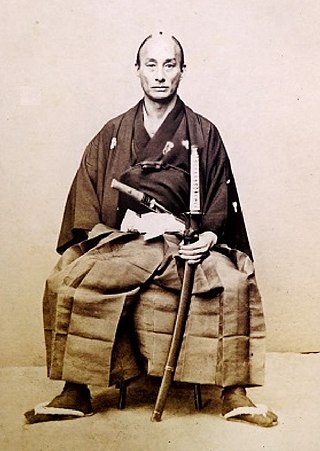
Moriyama Einosuke was a samurai during the Tokugawa shogunate, and an interpreter of Dutch and English. He studied English under Dutch merchants and Ranald MacDonald. He was called upon to assist shogunate officials during the "Manhattan Incident" of 1845, during which the American whaling ship Manhattan approached Edo to repatriate 22 castaway Japanese seamen. As Chief Dutch Interpreter, he was later one of the chief men involved in the negotiations with Commodore Perry in regard to the opening of Japan to the outside world.
Mary Huttleston "Mai" Coe was an American heiress and horticulturist who became the wife of William Robertson Coe, a businessman and philanthropist.
The Waterfront Historic Area LeaguE, also known as WHALE, is a non-profit historic preservation organization located in New Bedford, Massachusetts. Its mission is: "to promote the value and reuse of greater New Bedford's historic structures through preservation, education and advocacy". The organization often promotes its cause with the words of Sarah Delano. Delano said, "If you bulldoze your heritage, you become just anywhere".
The following is a timeline of the history of New Bedford, Massachusetts, United States.

Heart of a Samurai is a 2010 young adult historical novel by American author Margi Preus. The novel is closely based on the true story of Manjiro Nakahama (1827–1898) and is illustrated by his drawings, with jacket illustration by Jillian Tamaki. Heart of a Samurai has received numerous awards and honors, including being named as a Newbery Medal Honor Book in 2011.

Riverside Cemetery is a cemetery located in Fairhaven, Massachusetts at 274 Main Street. Laid out in the rural style, it was established in 1850 by Warren Delano II, the grandfather of Franklin Delano Roosevelt.

Mary Ann Tripp was the first American woman to visit China and also the first American woman to circumnavigate the Earth. She also visited the Philippine Islands during this historic trip. She then went on to travel the globe and visit China two more times before settling into a long life in Massachusetts.

New Bedford Friends Meeting House, also known as New Bedford Friends Meeting, is a Quaker house of worship in New Bedford, Massachusetts. This meeting house has since 1822 been the home to the New Bedford Meeting of the Religious Society of Friends (Quakers); the meeting meets every Sunday at 10:00 a.m.
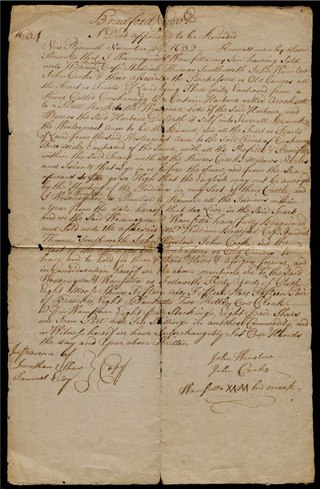
Old Dartmouth was the first area of Southeastern Massachusetts settled by Europeans. It was purchased on behalf of the Plymouth Colony in 1652 from the indigenous Wampanoag people. The lands included all of modern-day Dartmouth, New Bedford, Westport, Fairhaven, and Acushnet in current day Massachusetts, as well as parts of modern Tiverton and Little Compton In Rhode Island, an area of around 145,000 individuals in the modern area.
Cadmus was built in 1816 at Medford, Massachusetts. She made five complete voyages as a whaler, one out of Boston (1822–1825), and four out of Fairhaven, Massachusetts (1831–1841). She was lost in 1842 on an uncharted atoll in the Tuamotu Archipelago, that for a time was known as Cadmus Island, and is now known as Morane.
Cadmus was built in 1818 in New York. She was a packet sailing between New York and Havre. In 1824, Cadmus carried General Lafayette to New York on a visit at the invitation of the U.S. Congress. From 1827, Cadmus became a whaler, sailing from Sag Harbor, New York. She made 17 complete whaling voyages. During her whaling years Cadmus brought in oil and whale bone worth a total of $359,000. In 1849, a new owner sailed her to California so that he and his crew could take part in the gold rush there. They abandoned her in San Francisco, where she became a storehouse until she became too leaky; her bones were eventually buried under fill.
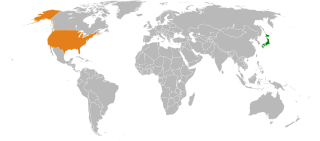
Japan and the United States have held formal international relations since the mid-19th century. The first encounter between the two countries to be recorded in official documents occurred in 1791 when the Lady Washington became the first American ship to visit Japan in an unsuccessful attempt to sell sea otter pelts. In the 1850s, Japanese ports were opened to American trade for the first time after the Perry Expedition, led by naval officer Commodore Matthew C. Perry, arrived in Japan with a fleet of four Black Ships. In July 1856, Townsend Harris became the first American diplomat to Japan, and in 1858, the Treaty of Amity and Commerce, also known as the Harris Treaty, further expanded trade relations and established permanent consulates. The first Japanese Embassy to the United States set sail for San Francisco in 1860, marking diplomatic engagement between the two nations.















